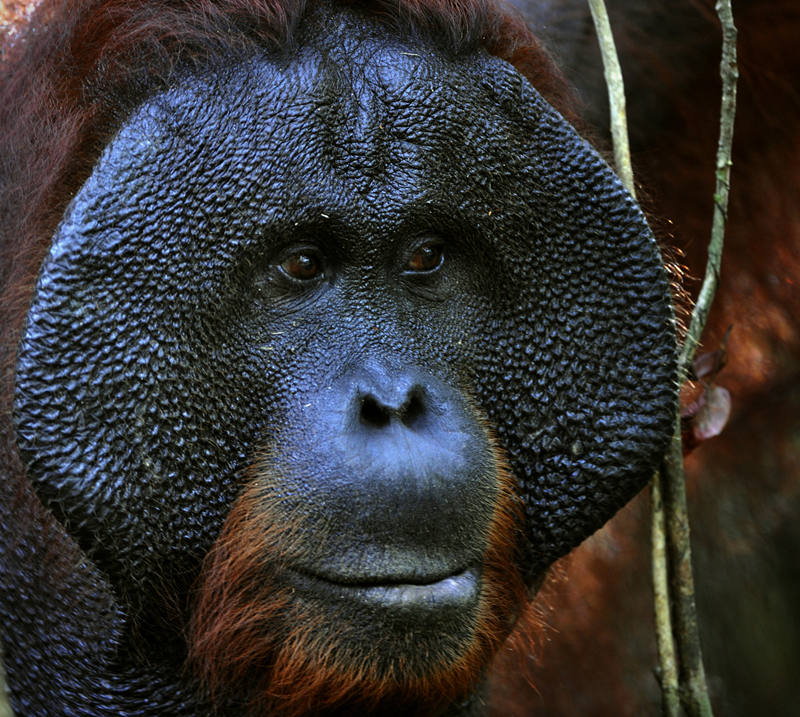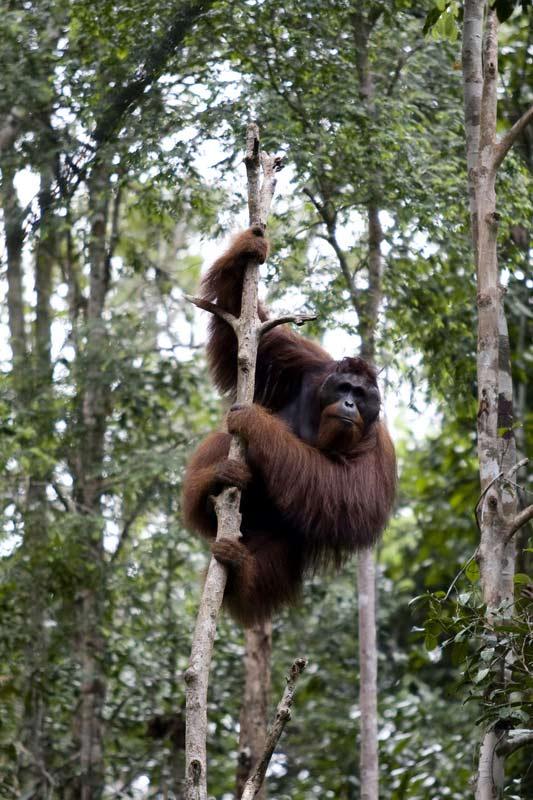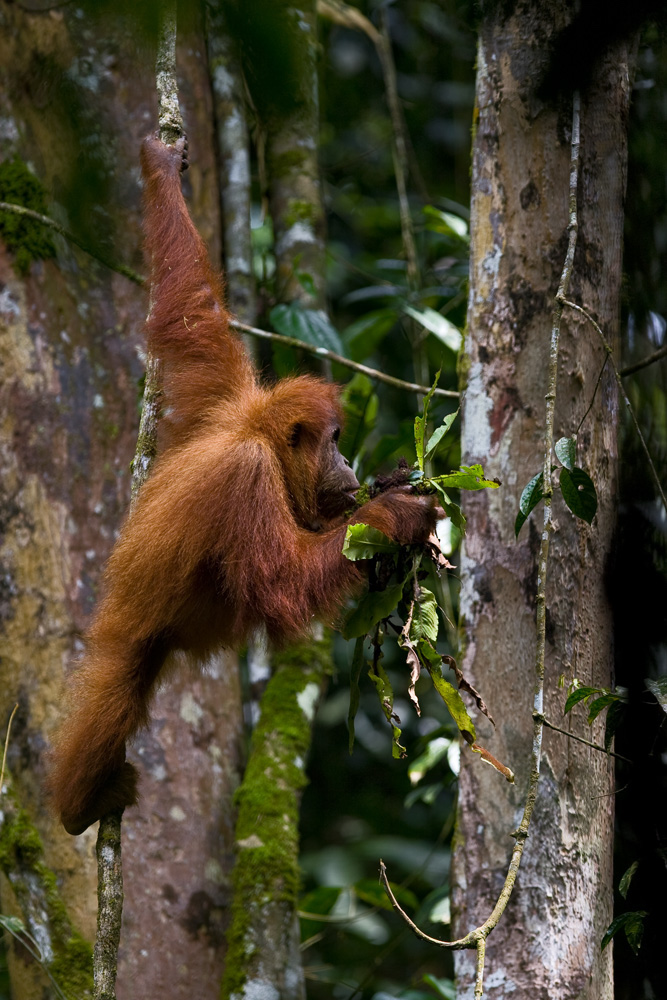Facts About Orangutans

Orangutans are great apes, a classification that includes gorillas, chimpanzees, bonobos and humans. They are the only great apes found in Asia. Orangutans are also the world’s largest arboreal mammals, which means they are the largest mammals that have the capability to live in trees.
Orangutans are endangered. They have become extinct in some parts of Asia, according to the San Diego Zoo. Most of their forest habitat in Borneo and Sumatra has been lost to make room for palm oil plantations.
Size
Orangutans are covered in long, flowing red or orange fur, except for their distinct bare faces. Their arms are longer than their bowed legs, and their hands much like human hands. Because orangutans spend most of their time in trees, their long arms, fingers and toes are quite useful as they swing from branch to branch. An orangutan’s arm-span is longer that its height. A male’s arm-span can reach 7 feet (2 meters) from fingertip to fingertip, according to National Geographic.
There are two species of orangutan. Bornean orangutans are more heavy-set than Sumatran orangutans, according to the San Diego Zoo. They also have larger cheek pads, called flanges, which form rigid half-circles on the sides of their faces. In both species, there are flanged males, which are twice the size of females, and unflanged males, which are around the same size as female orangutans. An unflanged male can become a flanged male, but scientists are uncertain as to why or how. Both unflanged and flanged males can produce offspring.
On average, orangutan females are around 45 inches (114 centimeters) tall, while males are around 54 inches (136 cm) tall. Females weigh an average of 81.5 lbs. (37 kilograms) and males average around 191 lbs. (87 kg).
Habitat
The name orangutan means "man of the forest" in the Malay language. Orangutans live in the rain forests of the islands of Sumatra and Borneo. They spend 90 percent of their time in the dense trees there, according to National Geographic. They even sleep in the trees, in nests of leafy branches, and they use large leaves as umbrellas.
Habits
Unlike other apes who have very strong social bonds, orangutans are considered semi-social. While they do hang out with other orangutans, they like to live alone for the most part.
Get the world’s most fascinating discoveries delivered straight to your inbox.
Orangutans are very smart and have a unique approach to problem solving, according to the San Diego Zoo. For example, "if a chimpanzee is given an oddly shaped peg and several different holes to try to put it in, the chimpanzee immediately tries shoving the peg in various holes until it finds the correct hole. But an orangutan approaches the challenge quite differently. It may stare off into space or even scratch itself with the peg. Then, after a while, it offhandedly sticks the peg into the correct hole while looking at something else that has caught its interest!"
Flanged males are very aggressive toward other males. They also have a throat sac that is used to make “long calls.” These calls can be heard 1.2 miles (2 kilometers) away, according to National Geographic. These long calls are useful for reaching females since orangutans are territorial. Females have territories that are around 3.5 square miles (9 square km) and males have territories that are around 15 square miles (39 square km), according to the San Diego Zoo.
Diet
Orangutans are omnivores, which means they eat vegetation and meat. Meat usually doesn’t come up on the menu, though. These apes are known to eat more than 500 different plant species, with fruits making up more than 60 percent of their average total food intake, according to the International Union for Conservation of Nature (IUCN). They also eat flowers, bark, insects and leaves.
Offspring
Female orangutans have some very unusual reproduction habits. They only give birth once every eight years, which is the longest time period in-between births of any animal, according to National Geographic. They are also fertile for more than 30 years.
Once pregnant, the female has a gestation period of eight to 10 months. She typically only gives birth to one baby at a time. The offspring, called babies or infants, just like humans, typically weighs 3.3 to 4.5 lbs. (1.5 to 2 kg).
The infant will cling to its mother’s belly fur as she climbs through the trees until it is a little older, then will ride on her back. Mothers and their children have a very close bond. They stick together for the baby’s first six or seven years of life. [Photos: Adorable Orangutan Shows Off Knot-Tying Skills]
Males typically leave and live alone for the rest of their lives while females have their own young to live with and care for. At 12, most females are mature enough to have their own children. Males don’t mature until age 15. Orangutans can live 30 to 40 years in the wild and up to 70 years in captivity.
Classification/taxonomy
This is the taxonomy of orangutans, according to Integrated Taxonomic Information System (ITIS).
Kingdom: Animalia Subkingdom: Bilateria Infrakingdom: Deuterostomia Phylum: Chordata Subphylum: Vertebrata Infraphylum: Gnathostomata Superclass: Tetrapoda Class: Mammalia Subclass: Theria Infraclass: Eutheria Order: Primates Suborder: Haplorrhini Infraorder: Simiiformes Superfamily: Hominoidea Family: Hominidae Subfamily: Ponginae Genus: Pongo Species: Pongo abelii (Sumatran orangutan), Pongo pygmaeus (Bornean orangutan)
Conservation status
According to the IUCN, Bornean orangutans are endangered, and Sumatran orangutans are critically endangered. The Sumatran orangutan has had an estimated decline in population of over 80 percent over the last 75 years, while the Bornean orangutan has had a population decline of well over 50 percent during the last 60 years. Their decline is due to loss of habitat from fires and deforestation. They are also hunted by poachers.
The World Wildlife Federation estimates there are 45,000 to 69,000 Bornean orangutans left in the wild, and only about 7,500 Sumatran orangutans. Orangutans are protected by laws in Malaysia and Indonesia. They are also protected by the Convention on International Trade in Endangered Species (CITES) and the U.S. Endangered Species Act.
Other facts
Orangutans are the largest fruit-eating animals on Earth. They have more than 300 types of fruit available to them.
These apes will use twigs to scoop termites out of holes in trees for a snack.
Orangutans have been known to watch humans use boats to cross rivers and then copy their movements to untie the boat and ride it across on their own, according to the San Diego Zoo.
Additional resources






